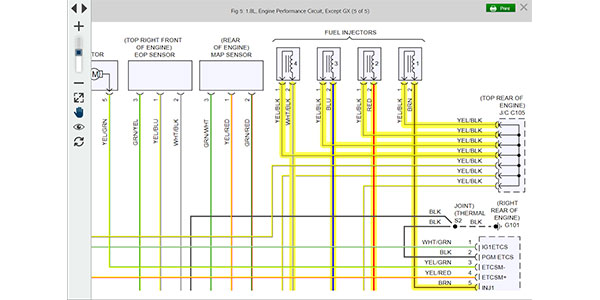
Contributing Editor
Realistically, I could have ignored it as it was not originally meant for me, and hindsight would suggest that might have been a better choice. But, e-mails, like ringing telephones, are particularly difficult to ignore, at least for very long.
Someone was doing research on the critical shortage of competent and qualified automotive repair technicians for a project focused on the financial impact and implications such a shortage might imply, and this person wanted to ensure his assumptions were correct. In order to do that, someone would have to take a look at the numbers. Since my career as a trade journalist started with a presentation focused on “the critical shortage of competent and qualified automotive repair technicians” circa 1984, and since I’ve been speaking and writing about it ever since, it seemed only reasonable to have me reflect on the current statistics.
There are dozens of factors that contribute to the belief there is such a shortage, just as there are dozens of arguments suggesting the shortage is nowhere near as acute as some would have you believe. Some people contend there is no shortage of people “working” on our cars and trucks; just a shortage of competent and qualified people. Others insist it isn’t a people problem; it’s a productivity problem, as if you can separate one from the other.
If you took into account the natural growth of the aftermarket due to increased vehicle registrations, the longer service life vehicles are providing their owners, and attrition — people dying, retiring or leaving the industry for other opportunities — the Bureau of Labor Statistics indicated we could instantly absorb 60,000 professional technicians in 1984.
That was a pretty scary number way back then; scary, but not really all that unbelievable if most of your time was spent looking for one of the more than 60,000 missing techs!
The e-mail that was forwarded to me suggested that in the almost 24 years that have passed since I delivered that first presentation, we’ve made amazing progress. We’ve gone from a shortfall of just over 60,000 technicians to a shortfall of just under 100,000!
Not bad when you consider we weren’t even trying!
As if the 34,000 jobs open due to growth and increased vehicle registration coupled with the approximately 60,000 jobs available through attrition weren’t enough to send you searching for the Lithium, it was followed by a statistic that was even more depressing: and that was the current median income for automotive service technicians.
What was it? What do you think it was? More important, perhaps: What do you think it should be?
According to BLS, the median income for folks who do what you and I do is $33,050. Now, just in case you were nodding off while Mr. Barton was droning on and on as he shared definitions of terms like range, mean, median and mode in third period Math class (like I was), median is the number that separates both halves of a universe of numbers. It’s the number dividing the higher half of a population or a distribution from the lower half. In simple terms, it’s the guy dead smack in the middle and, in this case, that $33,050 median income number stinks!
To compound matters even further, there was another number that appeared in the e-mail guaranteed to send you reeling. It was the projected cost of replacing an experienced worker at any age, in any industry, as a function of annual salary, and that number was 50%.
LET’S DO THE MATH
Why? How? Because it starts to look something like this…If you multiply half the median income of $33,050 ($16,525) times the 34,000 growth-related openings (that’s $561,850,000), and add it to half the median income of $33,050 times the 59,000 replacement related openings (that’s $974,975,000), you have an annual replacement cost of $1,536,825,000: more than a BILLION and a HALF!
Now, you can challenge these numbers, praying that they are somehow inaccurate: that they include lube techs in with the line techs, and maybe even line techs in with the ASE-Certified L1s. I did!
In fact, I went on a quest to prove they were wrong. My search led me to the Forbes magazine website and a list of the 10 highest-paying blue-collar jobs: no surprise, we weren’t anywhere to be found. However, I did learn that you can make anywhere from $50,300 as a Transportation Inspector at the low end, to $63,620 at the high end as an Elevator Installer or Mechanic. I don’t know about you, but I’ll bet anyone who can successfully work on a late-model passenger car or truck could force themselves to learn how to work on an elevator!
I went to bluecollarcrossing.com because it advertises it’s the largest listing of blue-collar jobs in the world. They had a different list of the Top 10 highest paying blue collar jobs and we weren’t there either. Aircraft mechanics were at an average wage of $27 per hour and an expected annual income of more than $55,000, as were Public Transportation Attendants at a projected annual income of more than $62,000; Longshore Equipment Operators at $58,000; Brick Masons and Power Plant Operators at between $56,000 and $57,000; and Locomotive Operators, Electric Power Plant Operators, Miners, Oil Well Drill Operators and Telephone Line Installer/Repairers at between $52,000 and $57,000.
From bluecollarcrossing.com I went to bizjournal.com where they listed more than 400 occupations and their expected average annual salaries. I found us listed in position 181 at an annual expected average income of $38,378 (mechanic apprentices were listed 280 at $29,072, not really all that much higher on the list than a “journeyman” level tech at $38,378!)! One hundred and eighty-one out of four hundred and one…Not much to be proud of there when carpet installers are listed at 157 ($42,584), electricians are listed at 99 ($52,686) and plumbers can be found on line 121 ($47,970).
I tried everything I could: I looked everywhere I could! I did the math: 45 hours times $20 per hour and felt a smile emerging, until I realized that most technicians are paid on the basis of the number of hours they bill, not the number of hours they work, and most shops are functioning at under 70% service bay productivity: $950 per week (with overtime) times 50 weeks equals $47,500…factored by 70%, and bingo, you’re right back to $33,250!
In the end, the bottom line will always be the bottom line, and regardless of who is included, that number is too damn low.
GETTING OUR FAIR SHARE
You have to wonder about what’s going on here? You have to wonder why we are not getting our “fair share.” You have to be at least a little curious as to how or why an elevator operator/installer is entitled to almost twice the income a certified automotive repair technician is likely to make. I know I am! What, if anything, makes them more entitled than you or me?
In the end there are lots of reasons. First of all, they ask for it. Or, perhaps more to the point, they demand it. Second, most people aren’t likely to hire someone off the street, someone without the appropriate education, certification or training to work unsupervised on the elevator in their 30-story building: not and ride the elevator themselves when the job was done! Certainly not as likely as they would be to take their vehicle to a facility in which just such a person was allowed to service, maintain or repair their $40,000 or $50,000 SUV or luxury sedan.
Third, you can’t just head for the airport after a couple of months of school and apply for a position as an aircraft engine mechanic: the Federal Aviation Administration frowns on it. In fact, they just won’t allow it!
Fourth, most of the other skilled trades are not forced to exist within an outdated, antiquated, piece-work, factory model that should have died generations ago. Most high-tech blue-collar workers are paid by the hour, not by how many strawberries they can pick in that hour.
And, finally, fifth, because time and space will not allow me to continue, we don’t talk to one another. We don’t communicate. We don’t cooperate. We don’t collaborate. Each shop is its own island: each technician is an independent contractor.
How are we supposed to attract young people with working conditions and compensation so obviously inadequate? How are we supposed to keep the talented, qualified and competent among us from leaving, when there is so little beyond the simple satisfaction we all know too well to keep us here?
How many shop owners or technicians would encourage their sons and daughters to join us when the work is so difficult and the rewards are so inadequate?
A good friend of mine once suggested that the secret to a long and happy life was to find something you loved to do, learn to do it well enough that someone would be willing to pay you to do it, and then learn to live on what it pays.
I think he almost had it right.
I think you should find something you love to do, learn how to do it well enough that someone would be willing to pay you do it, and then learn to make it pay would you need to live on!
I love this industry and I love the people in it. I know how hard it is to do what we do because I continue to force myself out into the shop to ensure I never forget just how difficult it has become. I’m watching every prediction I made in that first presentation in the fall of 1984 become a reality and it gives me no satisfaction whatsoever!
With the industry shrinking and graying, with more cars and work than our numbers can service properly, with people leaving the industry faster than we can replace them, we need to do something and we need to do it before we lose another minute.
We need to recognize that it’s our industry and that we are the only ones who can save it. We need to recognize that it’s our industry and that we are the only ones who can change it. We need to recognize that if an elevator mechanic can make $63,620 a year for making an elevator go up and down, you and I and everyone else in this industry should be smart enough, motivated enough, to force our expected average annual earnings to go up just as high and just as fast!






